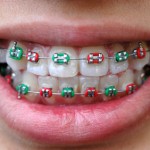
This clinical trial was one of the two included in the recently published Cochrane Review and has itself just been published. It was a multi-centred trial that took place at One District General Hospital Orthodontic Department and two Specialist Orthodontic Practices.
Orthodontic patients aged between 10 and 18 years old, were randomly allocated to either receive molar bands (n = 40) or molar bonds (n = 40). Bands were cemented with a conventional glass ionomer cement and tubes were bonded with light-cured composite to all four first permanent molar teeth for each subject. They were reviewed at each appointment for loosening or loss with the clinical endpoint being the day the appliance was removed, with enamel demineralisation at removal being assessed using the modified International Caries Assessment and Detection System (ICDAS).
They found:
- The first time failure rate for molar bonds was 18.4% and 2.6% for molar bands (P = 0.0002)
- Survival analysis demonstrated molar bonds were more likely to fail compared with molar bands
- First permanent molars with bonded tubes experienced more demineralization than those with cemented bands (P = 0.027)
- There was no statistically significant difference in discomfort experienced by patients after banding or bonding first permanent molars (P>0.05)
They concluded:
that as part of fixed appliance therapy, American Orthodontics photoetched first permanent molar bands cemented with 3M ESPE Ketac-Cem perform better than American Orthodontics low profile photo-etched and mesh-based first permanent molar tubes bonded with 3M Unitek Transbond XT in terms of failure behaviour and molar enamel demineralization.
Nazir M, Walsh T, Mandall NA, Matthew S, Fox D. Banding versus bonding of first permanent molars: a multi-centre randomized controlled trial. J Orthod. 2011 Jun;38(2):81-89.
